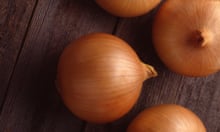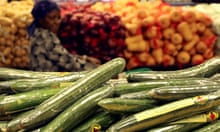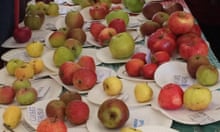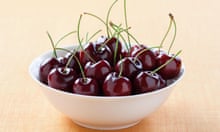Britain is enjoying a remarkable apple boom, as hundreds of new community orchards revive lost varieties and contribute to a thriving heritage market.
According to Steve Oram, who is the apple diversity officer at the wildlife charity People’s Trust for Endangered Species: “We are adding new orchards to the register all the time. Some are in allotments, others in schools and even housing developments.
“After the postwar years of neglect and destruction, when 90% of the UK’s orchards were lost and supermarkets sold only a few varieties and imported 70 to 80% of their apples, it is very exciting.”
The Newquay community orchard in Cornwall was started in 2015 with a £66,000 crowdfunding appeal. More than 2,000 trees, including 120 local heritage varieties, have been planted on land donated by the Duchy of Cornwall.
“It has been a huge success so far,” says operations manager Natalie Frost. “We have 300 volunteers and employ seven people – we haven’t even had a harvest yet. There’s a huge resurgence of people wanting to engage with nature. We find it is attracting schoolchildren, retirees, people from all parts of the community.”
Other community orchards are proving so popular they are being robbed of their harvest, possibly to supply the fast-growing “craft” cider market.
“Two weeks ago … someone got on to one orchard site with a truck and cleared every tree of the pear apple variety,” says David Curry from Plymouth who works with more than 20 community orchards “They left the rest. The pear apple is a lovely juicy, sweet apple. They knew what they were doing.”
The big growers say community orchards have found a niche. “There is a great interest now in growing heritage varieties. We are seeing a lot of small community orchards being planted with 100-odd trees,” says James Simpson, chair of trade body English Apples and Pears and one of Britain’s biggest apple growers. “These are starting to generate fruit and are supplying the growing heritage apple markets.”
Tom Adams, a young orchardist from Weston Rhyn, near Oswestry, Shropshire, who works with the Marcher Apple network of apple enthusiasts, is one of a growing number of apple detectives who are helping to track down and revive varieties of the fruit which were thought to have been lost for good.
He cites the case of bright yellow apples found on an old tree in a neglected orchard in south Shropshire. The single tree was an ecological and historical mystery: no one knew when it was planted and there was no mention of it in the national fruit collection of more than 2,200 apple varieties.

“It was probably 100 years old and the only one of its kind left. It was a lost variety. Its DNA was tested and it was shown to be unique,” said Adams. The tree is one of more than 60 “lost” varieties which have been found growing near the Welsh border. After several years of research it was last year identified as a Bringewood pippin, first bred in the early 19th century by horticulturalist Thomas Andrew Knight. All 60 varieties have now been saved.
The Marcher group is part of a burgeoning movement of growers and enthusiasts using old books and modern DNA testing to identify, propagate, and popularise Britain’s wealth of rare apples. Many, like Adams, who grows more than 50 varieties are also selling heritage trees.
“They are finding, protecting and naming hundreds of apple varieties,” says Oram. “There are possibly thousands more varieties waiting to be discovered. Many were never recorded by the authorities or commercial growers but were grown by farmers, smallholders and households. We know of 924 varieties being grown which are not registered at Brogdale but there are probably hundreds more. About 300 are cider varieties.”
Some of those found have no names; others are being named after the person or place they were found or what they look like. New names added recently include Halfpenny Green B, Link Wonder, Nancy Crow and Burr Knot.
Sue Clifford, founder of the Common Ground environment group, which launched a movement to save traditional orchards nearly 30 years ago, and came up with the idea of an annual apple day, says apple awareness is now high and a corner may have been turned.
“Until quite recently, every farm, country house and suburban garden had its own collection of fruit trees. We lost nearly all these old orchards in the 1970s and 80s. We are in a far better place than we were then, but we were starting at a very low point.
“It is astonishing how people have picked up the idea of planting small orchards. There is much more planting now, a growing urban and rural movement and a resurgence of interest in ciders. Community orchards are becoming very important to places, and people are rightly proud of them. Apple Day has become a new harvest festival.
“But supermarkets were always the problem and they still are. Only one in three apples we eat comes from the UK, and they are still selling apples from Australia. They are just not thinking. They could do much better.”
BRITISH BITES
Colwall Quoining
Dessert apple named after a village near Malvern, Worcestershire. It has angular ridges – ‘quoining’ refers to its corners – and crisp, coarse flesh with a sweet, nutty flavour. Green with splashes of red. Available January to October.
Pig’s Nose Pippin
Named after its flattish top, resembling a pig’s snout. It has a sweet and aromatic flavour. Available mid-October.
Byford Wonder
It has yellowish flesh and a sharp and aromatic flavour. Available in October.
Ten Commandments
Red apple ready late September. Its name refers to the 10 red spots that feature around the core – visible when sliced in half.
Brithmawr Forester
A South Wales apple that can be used for cooking, eating fresh or cider. Ready for picking from mid-September.











Comments (…)
Sign in or create your Guardian account to join the discussion